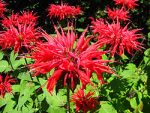 Also known as oswego tea, this clump-forming herbaceous perennial is a member of the deadnettle family, Lamiaceae, that also includes mint, basil, and adjuga. It is native to eastern North America from Maine to northern Georgia and west to Ontario and Minnesota where it grows in moist areas such as bottomlands, thickets. and stream banks and may produce substantial colonies. Plants grow 2-4′ tall and have 4-sided stems bearing thin pointed ovate to lanceolate leaves that are 4-6″ long. The leaves are dark green with reddish veins, have coarsely toothed margins and give off a minty fragrance when crushed. Bright red tubular flowers surrounded by reddish bracts are carried in globose terminal, whorled clusters 3-4″ across and composed of up to 30 flowers. The flowers bloom from mid- to late summer and are attractive hummingbirds, butterflies and bees. Native Americans followed by early settlers have used the plant to make a tea valued for both culinary and medicinal purposes. Many cultivars are available that vary most significantly in color, vigor, and disease resistance. An excellent choice for the border as well as for a bird, butterfly, native plant, or herb garden. The genus name, Monarda, honors Nicolas Monardes (1493-1588), physician and botanist of Seville who described the first American flora in 1569. The specific epithet, didyma, is the Greek word meaning twin and refers to stamens that occur in pairs.
Also known as oswego tea, this clump-forming herbaceous perennial is a member of the deadnettle family, Lamiaceae, that also includes mint, basil, and adjuga. It is native to eastern North America from Maine to northern Georgia and west to Ontario and Minnesota where it grows in moist areas such as bottomlands, thickets. and stream banks and may produce substantial colonies. Plants grow 2-4′ tall and have 4-sided stems bearing thin pointed ovate to lanceolate leaves that are 4-6″ long. The leaves are dark green with reddish veins, have coarsely toothed margins and give off a minty fragrance when crushed. Bright red tubular flowers surrounded by reddish bracts are carried in globose terminal, whorled clusters 3-4″ across and composed of up to 30 flowers. The flowers bloom from mid- to late summer and are attractive hummingbirds, butterflies and bees. Native Americans followed by early settlers have used the plant to make a tea valued for both culinary and medicinal purposes. Many cultivars are available that vary most significantly in color, vigor, and disease resistance. An excellent choice for the border as well as for a bird, butterfly, native plant, or herb garden. The genus name, Monarda, honors Nicolas Monardes (1493-1588), physician and botanist of Seville who described the first American flora in 1569. The specific epithet, didyma, is the Greek word meaning twin and refers to stamens that occur in pairs.
Type: Herbaceous perennial
Bloom: Bright red tubular flowers surrounded by reddish bracts are carried in globose terminal, whorled clusters of up to 30 from mid- to late summer . Cultivars may have white to pink, red or purple flowers.
Size: 2-4′ H x 2-3′ W
Light:Full sun to part shade
Soil: Average, medium moist to wet, well-drained; plants should not dry out.
Hardiness: Zones 4-9
Care: Plant so that air circulation is good to reduce fungal disease; divide every 3-4 years; deadhead after flowering to reduce spread by seed.
Pests and Diseases: Powdery mildew, rust; spraying with a fungicide may be necessary.
Propagation: Seed, division
Companion Plants: Veronica ‘Goodness Grows’ (or similar), phlox, purple coneflower (in white or pink), black eyed Susan
Outstanding Selections:
‘Cambridge Scarlet’ (flaming red flowers, very vigorous)
‘Croftway Pink’ (soft pink flowers)
‘Snow White’ (creamy white flowers; 3′ tall)
‘Viiolet Queen’ (dark purple flowers)
Photo Credit: Wikimedia